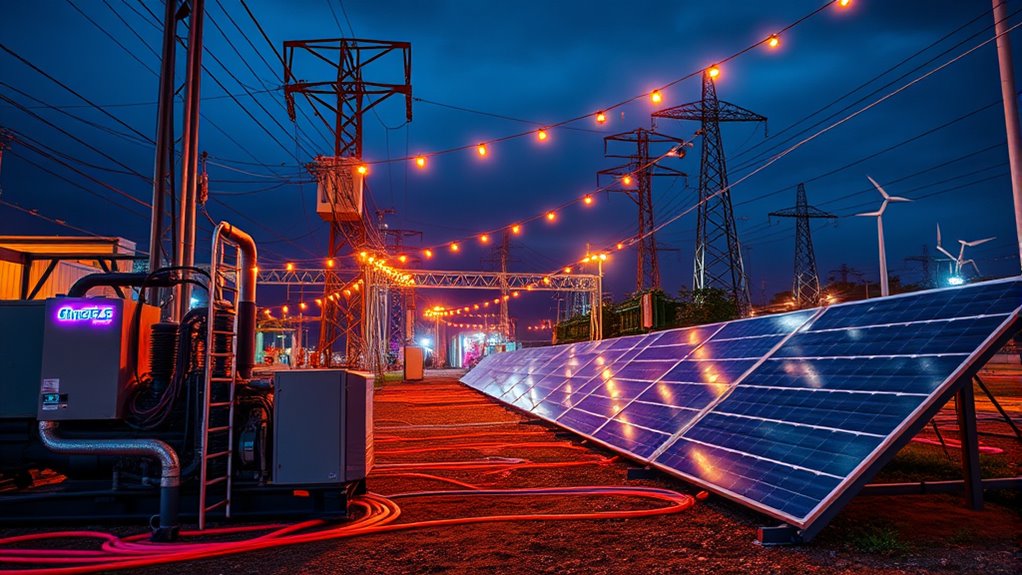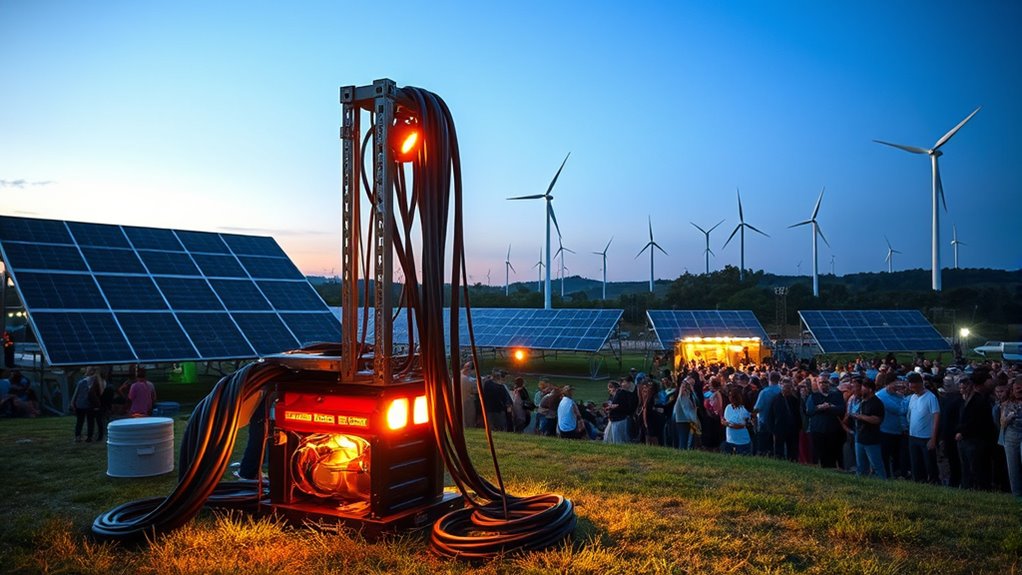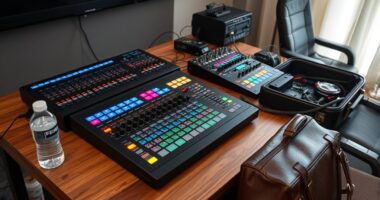To power a festival, you can use traditional generators running on diesel or gasoline for reliable energy, but increasingly, green tech options like biodiesel, solar, and wind are popular for their eco-friendly benefits. Smart grids and microgrid systems help balance energy loads and reduce reliance on polluting generators. Combining these solutions ensures continuous, sustainable power. If you want to explore how to optimize festival energy sources further, there’s more to uncover below.
Key Takeaways
- Traditional festival power relies on diesel or gasoline generators, but eco-friendly alternatives like biodiesel and hybrid systems are gaining popularity.
- Microgrid and smart grid technologies optimize energy distribution, integrating renewables, batteries, and traditional sources for efficiency and resilience.
- Renewable energy sources such as solar and wind, combined with energy storage, provide sustainable, reliable power for festival operations.
- Green tech reduces environmental impact by lowering emissions, noise, and fuel consumption, supporting eco-conscious festival planning.
- Implementing these technologies ensures cost savings, operational reliability, and demonstrates a commitment to sustainability.

Ever wondered how large festivals keep the lights on and the music flowing without harming the environment? The secret lies in a combination of traditional generators, smart grid systems, and innovative green technologies. When you’re at a festival, you might see massive generators fueling stages and food stalls. These generators typically run on diesel or gasoline, providing reliable power but often contributing to air pollution and noise. That’s why many organizers are shifting toward cleaner options to reduce their carbon footprint. You might notice some festivals employing biodiesel generators, which use renewable plant-based fuels that produce fewer emissions. Others are experimenting with hybrid setups, combining traditional generators with battery storage to cut down on fuel consumption and noise. These hybrid systems store excess energy during low demand periods and deploy it when needed, making power use more efficient.
Beyond generators, smart grid technology plays a crucial role in managing energy flow. Instead of relying solely on isolated power sources, festival organizers are increasingly adopting microgrids—localized, self-sufficient energy networks. These microgrids integrate various power sources, including renewables, batteries, and traditional generators, to optimize energy distribution. They can automatically balance supply and demand, ensuring that power is delivered where it’s needed without waste. This approach reduces reliance on large, pollutant-emitting generators and enhances resilience during outages or unexpected demand spikes. You might see festival layouts designed around these grids, with energy flows monitored in real-time on control dashboards, allowing organizers to make swift adjustments and avoid energy shortages.
Microgrids optimize energy flow, reduce waste, and enhance resilience at festivals through real-time monitoring and smart distribution.
Green technology doesn’t stop at energy sources. Sustainable practices extend to energy storage and management as well. For example, some festivals install large-scale solar panels or wind turbines to generate clean energy on-site. Portable solar units are common for smaller setups or areas away from main power sources. Energy storage batteries also come into play, capturing excess renewable energy for later use, especially during nighttime or low sunlight hours. Additionally, integrating energy-efficient equipment helps minimize overall energy consumption and environmental impact. This shift toward green tech isn’t just about reducing emissions; it also helps festivals operate more reliably and cost-effectively in the long run. As a participant, you might notice quieter, more eco-friendly operations and a deeper sense of commitment to sustainability.
In the end, powering a festival today involves a mix of tried-and-true methods and cutting-edge innovations. By embracing green tech, organizers can keep the party alive while protecting the environment, ensuring that future festivals can continue to bring joy without leaving a heavy ecological footprint.
Frequently Asked Questions
How Do Festival Organizers Decide Between Generators and Grid Power?
You decide between generators and grid power based on your festival’s size, location, and sustainability goals. If the event is remote or temporary, generators are your go-to for reliable, portable energy. For larger or eco-conscious festivals near existing infrastructure, grid power may be more cost-effective and environmentally friendly. You weigh logistical factors, costs, and environmental impact to choose the best option that keeps your event running smoothly.
What Are the Safety Protocols for Using Large Generators at Festivals?
You should always conduct a thorough risk assessment before using large generators. Make certain they’re placed on stable, level surfaces away from crowds and flammable materials. Use proper grounding and install safety barriers to prevent accidental contact. Regularly inspect cables and connections for damage, and ensure fire extinguishers are nearby. Train staff on emergency procedures, and keep detailed logs of maintenance and inspections to guarantee safe operation throughout the festival.
How Do Green Technologies Compare in Cost and Efficiency to Traditional Power Sources?
Green technologies often cost more upfront but can be more efficient and cheaper in the long run. You might spend less on fuel and maintenance, and enjoy tax incentives or subsidies. While traditional power sources like diesel generators are initially cheaper, they tend to be less sustainable and more polluting. Investing in green tech can boost your festival’s eco-credibility and reduce operational costs over time, making it a smart choice.
Are There Any Regulations for Incorporating Renewable Energy at Festivals?
Yes, there are regulations you’ll need to follow when incorporating renewable energy at festivals. You must obtain permits from local authorities, ensure compliance with safety standards, and adhere to environmental guidelines. Some regions also require environmental impact assessments or specific approvals for certain technologies like solar or wind. It is crucial to research your area’s rules early, work with local agencies, and consult experts to guarantee your sustainable energy plans meet all legal requirements.
How Can Attendees Reduce Their Energy Footprint During Festivals?
You can reduce your energy footprint at festivals by bringing reusable, energy-efficient devices like LED lanterns or solar-powered chargers. Limit your use of single-use batteries and unplug devices when not in use. Opt for sustainable transportation to and from the event, like biking or carpooling. Be mindful of waste, and support vendors offering eco-friendly products. Small actions like these help lower your impact and promote greener festivals.
Conclusion
As you navigate the world of festival energy, remember that choosing between traditional generators, grid connections, or green tech is like steering a ship through changing tides. Your decision impacts not just the event’s success but also the environment’s health. By embracing sustainable options, you become a beacon of hope, guiding the industry toward a greener horizon. Together, you can turn the festival into a shining example of innovation and responsibility — a lighthouse in the night.










